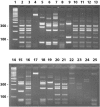Forty-eight-hour diagnosis of onychomycosis with subtyping of Trichophyton rubrum strains
- PMID: 16597871
- PMCID: PMC1448676
- DOI: 10.1128/JCM.44.4.1419-1427.2006
Forty-eight-hour diagnosis of onychomycosis with subtyping of Trichophyton rubrum strains
Abstract
A novel strategy for the molecular identification of fungal agents of onychomycosis (including Trichophyton rubrum) has been designed based on the use of species-specific and universal primers in conjunction with a commercial kit that allows the extraction of DNA directly from the nail specimens. The microsatellite marker T1, which is based on a (GT)n repeat, was applied for the species-specific identification of Trichophyton rubrum. To evaluate how often Scopulariopsis spp. are detected in nail specimens, a second primer pair was designed to amplify specifically a 336-bp DNA fragment of the 28S region of the nuclear rRNA gene of S. brevicaulis and closely related species. Other fungal species were identified using amplification of the internal transcribed spacer (ITS) region of the rRNA gene, followed by restriction fragment length polymorphism analysis or sequencing. In addition, polyacrylamide gel separation of the T1-PCR product allowed subtyping of T. rubrum strains. We studied 195 nail specimens (the "nail sample") and 66 previously collected etiologic strains (the "strain sample") from 261 onychomycosis patients from Bulgaria and Greece. Of the etiologic agents obtained from both samples, T. rubrum was the most common organism, confirmed to be present in 76% of all cases and serving as the sole or (rarely) mixed etiologic agent in 199 of 218 cases (91%) where the identity of the causal organism(s) was confirmed. Other agents seen included molds (6% of cases with identified etiologic agents; mainly S. brevicaulis) and other dermatophyte species (4%; most frequently Trichophyton interdigitale). Simultaneous infections with two fungal species were confirmed in a small percentage of cases (below 1%). The proportion of morphologically identified cultures revealed by molecular study to have been misidentified was 6%. Subtyping revealed that all but five T. rubrum isolates were of the common type B that is prevalent in Europe. In comparison to microscopy and culture, the molecular approach was superior. The PCR was more sensitive (84%) than culture (22%) in the nail sample and was more frequently correct in specifically identifying etiologic agents (100%) than microscopy plus routine culture in either the nail or the strain samples (correct culture identifications in 96% and 94% of cases, respectively). Using the molecular approach, the time for diagnosing the identity of fungi causing onychomycosis could be reduced to 48 h, whereas culture techniques generally require 2 to 4 weeks. The early detection and identification of the infecting species in nails will facilitate prompt and appropriate treatment and may be an aid for the development of new antifungal agents.
Figures


Similar articles
-
Five-hour diagnosis of dermatophyte nail infections with specific detection of Trichophyton rubrum.J Clin Microbiol. 2007 Apr;45(4):1200-4. doi: 10.1128/JCM.02072-06. Epub 2007 Jan 31. J Clin Microbiol. 2007. PMID: 17267633 Free PMC article.
-
Fast and sensitive detection of Trichophyton rubrum DNA from the nail samples of patients with onychomycosis by a double-round polymerase chain reaction-based assay.Br J Dermatol. 2007 Oct;157(4):698-703. doi: 10.1111/j.1365-2133.2007.08110.x. Epub 2007 Aug 21. Br J Dermatol. 2007. PMID: 17714569
-
[DNA extraction and identification of Trichophyton rubrum by real-time polymerase chain reaction from direct nail scraping specimens of patients with onycomycosis].Mikrobiyol Bul. 2011 Jan;45(1):150-8. Mikrobiyol Bul. 2011. PMID: 21341169 Turkish.
-
[Mycological diagnosis of onychomycosis].J Mycol Med. 2014 Dec;24(4):269-78. doi: 10.1016/j.mycmed.2014.10.006. Epub 2014 Nov 20. J Mycol Med. 2014. PMID: 25458363 Review. French.
-
[Etiopathogenesis, clinical picture and diagnosis of onychomycoses].Med Pregl. 2001 Jan-Feb;54(1-2):45-51. Med Pregl. 2001. PMID: 11432322 Review. Croatian.
Cited by
-
Multicenter evaluation of a commercial PCR-enzyme-linked immunosorbent assay diagnostic kit (Onychodiag) for diagnosis of dermatophytic onychomycosis.J Clin Microbiol. 2007 Apr;45(4):1205-10. doi: 10.1128/JCM.01418-06. Epub 2007 Feb 7. J Clin Microbiol. 2007. PMID: 17287330 Free PMC article.
-
Strain differentiation of dermatophytes.Mycopathologia. 2008 Nov-Dec;166(5-6):319-33. doi: 10.1007/s11046-008-9108-1. Epub 2008 May 14. Mycopathologia. 2008. PMID: 18478358 Review.
-
Polymerase Chain Reaction-Restriction Fragment Length Polymorphism as a Confirmatory Test for Onychomycosis.Open Access Maced J Med Sci. 2018 Feb 14;6(2):280-283. doi: 10.3889/oamjms.2018.098. eCollection 2018 Feb 15. Open Access Maced J Med Sci. 2018. PMID: 29531588 Free PMC article.
-
Molecular approaches in the diagnosis of dermatophytosis.Mycopathologia. 2008 Nov-Dec;166(5-6):307-17. doi: 10.1007/s11046-008-9107-2. Epub 2008 May 15. Mycopathologia. 2008. PMID: 18481195 Review.
-
A six-year retrospective study on the causative agents of onychomycosis in China: the emergence of dematiaceous fungi.Front Microbiol. 2025 May 1;16:1582147. doi: 10.3389/fmicb.2025.1582147. eCollection 2025. Front Microbiol. 2025. PMID: 40376466 Free PMC article.
References
-
- Achten, G., and J. Wanet-Rouard. 1978. Onychomycosis in the laboratory. Mykosen 23(Suppl. 1):125-127. - PubMed
-
- Andre, J., and G. Achten. Onychomycosis. 1987. Int. J. Dermatol. 26:481-490. - PubMed
-
- Baek, S. C., H. J. Chae, D. Houh, D. G. Byun, and B. K. Cho. 1998. Detection and differentiation of causative fungi of onychomycosis using PCR amplification and restriction enzyme analysis. Int. J. Dermatol. 37:682-686. - PubMed
-
- Barranco, V. 1994. Proceedings and transactions of onychomycosis. Int. J. Dermatol. 33:292-299. - PubMed
-
- Bock, M., M. Maiwald, R. Kappe, P. Nickel, and H. Näher. 1994. Polymerase chain reaction-based detection of dermatophyte DNA with fungus-specific primer system. Mycoses 37:79-84. - PubMed
Publication types
MeSH terms
Substances
LinkOut - more resources
Full Text Sources
Miscellaneous

